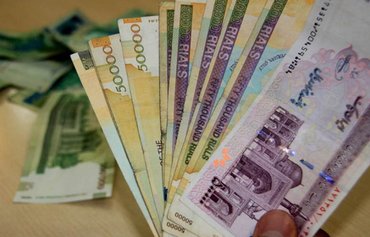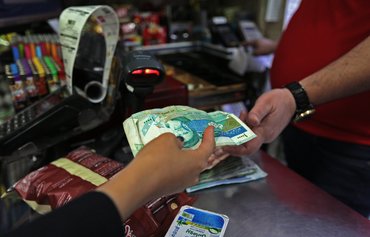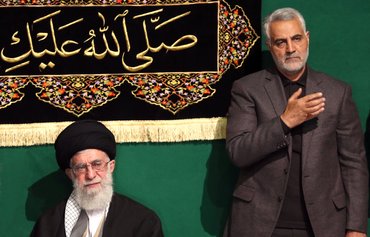As state funds continue to flow out of Iran to support proxy wars in Syria and Yemen and militias in other countries, millions of Iranians are out of work, and the country's economy is in tatters, experts tell Al-Mashareq.
Yet Iran's Islamic Revolutionary Guard Corps (IRGC) continues to fund its proxies to expand its influence across the region, said Cairo University doctoral student Sheyar Turko, who has been researching the financing of the IRGC.
The IRGC has a pattern of establishing or supporting armed groups so it can "sneak in under the cover of defending the oppressed and the members of the Shia sect" and expand its own influence, he told Al-Mashareq.
"The extremely high costs incurred by the IRGC for building and supporting armed groups around the world are inevitably reflected directly on the economic situation in Iran and on the Iranian people’s living conditions," he said.
Heavy spending on foreign militias
In a study published in April, Iranian affairs analyst and Foundation for Middle East Studies in Paris researcher Mohammad Amin revealed that the IRGC spends heavily on militias fighting its proxy wars, Turko said.
According to the study, the budget for Iran's new fiscal year (March 2017 through March 2018) allots more than 85,899 billion tomans ($24.5 billion) to military and security issues, or 23% of the country's overall budget.
The budget does not itemise the support given to the militias but includes it under headings such as "charity" and "Islamic cultural matters", the study said.
Financing for these groups is estimated at $7 billion, the study said, and is provided partly through the revenues of the Imam Khomeini Relief Foundation (IKRF) and the Basij Co-operative, and partly from the state’s budget.
According to the study, the groups supported by the IRGC "are concentrated in Iraq" and include the Badr Organisation, al-Nujaba Movement, Asaib Ahl al-Haq, Kataib Hizbullah, Imam Ali Brigades, al-Khorasani Brigade, Sayyid al-Shuhada Brigades and Abu al-Fadl al-Abbas Brigade.
Support to Iraq-based groups is estimated at $1.5 to $3 billion a year.
In Yemen, the Houthis (Ansarallah) receive an estimated $1.5 to $2.5 billion a year, while in Lebanon, Hizbullah receives $1 to $1.5 billion.
According to the study, the IRGC also supports the Fatemiyoun Brigade in Afghanistan ($150 million annually), and the Zainabiyoun Brigade in Pakistan ($100 million annually), as well as other foreign militias.
Decline in public purchasing power
Iranian writer and political analyst Ali Narimani told Al-Mashareq the Iranian regime has starved its own people as it pursues its expansionist agenda abroad.
Since it came to power, the regime has relied on internal repression and interference in the affairs of other countries to achieve its goals, he said.
"But the Iranian people are fed up," he said. "Not a day passes in Iran without various segments of the Iranian population staging dozens of protests and strikes," with university students and workers demonstrating in various cities.
Many protesters express the view that instead of spending vast sums in Syria and on supporting the Houthis in Yemen and Lebanon's Hizbullah, state funds ought to be spent inside the country on improving living conditions.
"The minimum [monthly] wage in Iran is 930,000 tomans ($290) and this amount is several times lower than what it needs to be to enable workers and their families to meet their basic needs," said Hussein Shayan, a youth from Tehran who holds a bachelor's degree in economics.
This is not enough to meet the basic needs of a family of three, he said.
The decline in public spending was widely reported on the eve of the Iranian New Year, when people typically shop for new clothes and other items, he said.
"They are not buying anything, not even new clothes, which is one of the most important rituals of the New Year," he said, adding that this is a sign of a decline in income and purchasing power and an increase in economic stagnation.
World Bank figures put Iran's unemployment rate at 12.7% in the second quarter of 2016.
Elections bring tensions to light
Inside Iran, the presidential elections have brought internal tensions between the various wings of the regime to light, Shayan said.
Poverty and unemployment have become major points of contention, he said, with many expressing anger about the flow of Iranian funds to countries where the IRGC is fighting proxy wars at the expense of the Iranian people.
"Homelessness has become prevalent among large segments of society," he said, adding that "we must not be fooled by the slogans that the regime uses to try to justify its interference in neighbouring countries".
The best way to determine whether the regime is on the right path is to examine the living conditions of the various segments of Iranian society, he said.
Many Iranian families are miserable, he added, pointing to a July 26th, 2016, report published by Javan newspaper which indicates that 9.7 million Iranian workers are living below the poverty line.

![Iranian soldiers march during an April 18th parade in Tehran marking National Army Day. [Atta Kenare/AFP]](/cnmi_am/images/2017/05/08/7816-Iran-army-parade-600_384.jpg)







Many thanks to the administrators of the Al-Mashareq portal. If it is possible, please add the English news section to the Al-Mashareq portal.
Reply1 Comment(s)